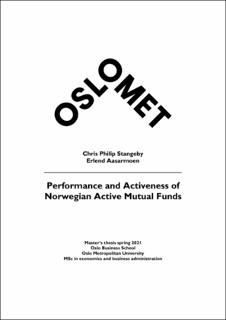| dc.description.abstract | This paper aims to investigate the performance and activeness of active open-end mutual
funds in Norway in the time period 2010 to 2020. The study uses a dataset free of
survivorship bias by including delisted funds in the period. Using R2
and tracking error as measurements of activeness, we identify 98 active mutual funds of
which seven are presumed closet indices. Our findings are in line with previous literature,
suggesting active fund's ability
to outperform the index gross of fees is present, but not with expenses taken into
consideration. Further, our analysis implies that a more significant share of active funds
outperforms the global market over the domestic market. These results deviate from previous
Norwegian literature in one area: previous research favors active management invested
domestically, while our model suggests they perform better globally than domestically. This
may be due to different sample periods or the new cost structure of funds after the
introduction of the MIFID-II law.
Further, funds operate with different minimum investments and expenses. We found a
correlation regarding minimum first-time deposit and expenses for each fund - minimum
deposits increase, causing the average fees to decrease. Our models suggest the
performance
is close to equal for funds with high and low minimum deposit, gross fees. This indicates that
retail investors (i.e., investors with less than NOK 500.000 to investment) have less to gain by
choosing active funds, over institutional investors, because of the increase in the expenses.
Finally, to measure managers' risk-adjusted return, we apply a Sharpe ratio to evaluate the
risk
associated with each fund's return. This shows how much additional return an investor earns
by taking additional risk. We conclude that the average fund is able to deliver satisfying
ratios; only 11,2% of our fund sample underperform on this measurement. Overall, we cannot
conclude that Norwegian active mutual fund’s either outperform or underperform the index
regarding risk-adjusted excess returns net fees because of the lack of sufficient significant
alphas. | en_US |
